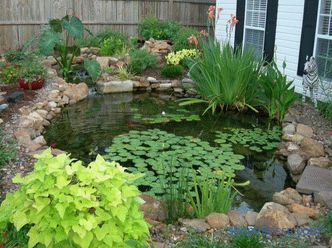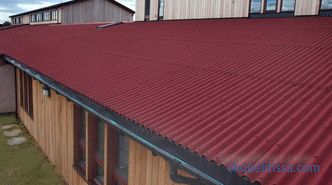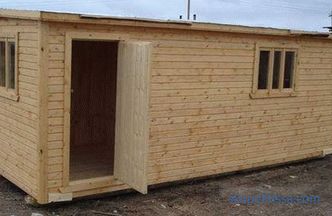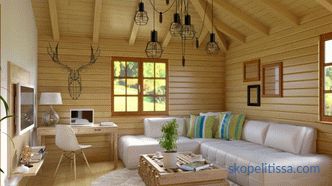The ceramic block (the product, which is referred to as a ceramic stone by GOST), has become a new link in the chain of products made from clay. The material appeared in response to new requirements for building technologies; despite the short career so far, ceramic blocks could show themselves as a promising wall material with an impressive array of qualities. It is not for nothing that blocks have so many alternative names - they are referred to as warm or porous ceramics, thermal blocks or as a large-format stone.
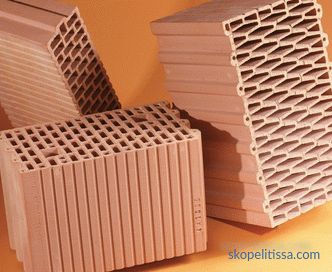
About the production of ceramic blocks
With its predecessors - the classic red and hollow bricks, The ceramic block has a certain similarity, both in the initial raw material and in some operational characteristics. At the same time, the production process is more technological, which affects the final cost not for the better, but is compensated by the quality of the product. The usual kind of ceramic blocks is obtained at the end of the following technological chain:
-
Preparation of raw materials . Clay is mixed with the expander - additives that reduce the density and set the thermal parameters of the products. Chopped sawdust, cereal husks, waste paper or polystyrene can act as additives. The mixture is passed through an alumina machine (which makes it homogeneous), and through a press that removes excess water.
-
Molding . The prepared clay mass in the form of a bar is pressed through a high-strength form (die), which forms the external surfaces and voids of future blocks.
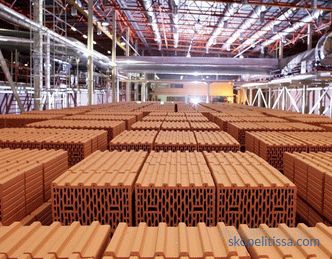
-
Drying and roasting . Clay bar is cut into individual products and dried in a special chamber; the process takes from two to three days. The subsequent calcination takes place in a tunnel kiln, it lasts 40-50 hours at 1000 ° C. At such a temperature regime, the clay turns into ceramics, and the piercing substances burn out, forming internal pores.
About the shape and size of ceramic blocks
Ceramic blocks are factory-made products with a quality conforming to GOST (which is monitored throughout the entire production cycle). A block, like a brick, has the shape of a parallelepiped. This is where the similarity ends; otherwise, the appearance can be described by the following parameters:
-
Structure . The entire volume of the ceramic block, with the exception of external (narrow) surfaces, is penetrated by slotted voids. The side surfaces that form the vertical joints during the laying, form a groove-ridge system, which allows you to not use the solution.
-
Dimensions . 14 block sizes are made, which makes it possible to produce masonry 250, 380 and 510 mm thick (the wall thickness is determined by the length of the products).
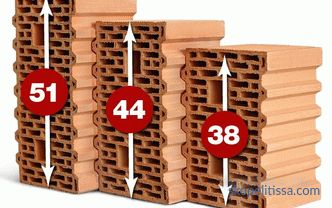
-
Popular sizes (LxWxH). In private house building, ceramic blocks have been used, their dimensions are 250, 380 or 510 mm in length, 120, 180 or 250 mm in width, and 140, 188 or 219 mm in height.
-
Types of products . Ceramoblocks are conventionally divided into rank and file (for masonry wall structures) and additional (for forming door and window openings).
-
Deviations in sizes . Maximum deviations are not more than 10 mm in length (in both directions), 5 mm in width, 4 mm in thickness. External walls should not be thicker than 8 mm.
-
Size comparison . A porous stone with a size of 250x120x140 mm will replace 2.1 classic construction bricks, a block with a size of 380x250x219 mm - 10.7 bricks.
-
Usage . For exterior walls use ceramic blocks with a length of 300-510 mm. Interior partitions are constructed from a material size of 250 mm.
-
Density . By density (on which strength and heat efficiency depend), products are distributed in the following way: up to 700 kg / m 3 , 710-800 kg / m 3 , 810-1000 kg / m 3 , 1010-1200 kg / m 3 . Blocks are marked from M25 to M175, sometimes M200 and more.
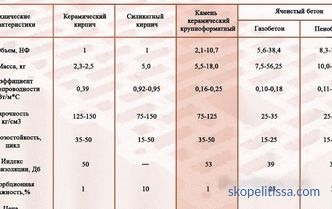
On our site you can find contacts of construction companies that offer a service building houses from keramoblokov. Directly to communicate with representatives, you can visit the exhibition of houses "Low-rise Country".
Why walls from heat blocks are warm
It is known from a school physics course that air is the best heat insulator. The external structure of a large-format porcelain block includes many air chambers, which has a positive effect on its heat-shielding characteristics. This means that the main thermal energy does not go out through these air pockets, but through ceramic bridges, that is, slower, since this winding path is twice as long as the block thickness.A concrete block with the same dimensions will be significantly colder. Decent performance of walls made of ceramic blocks is provided with other useful properties:
-
Low water absorption . Under conditions of high humidity, the thermal conductivity of the porous block will be lower than that of aerated concrete.
-
Internal pore structure . Air cavities (pores) that have arisen during the firing of ceramics and burnout of penetrating additives, make the product easier.
-
Appearance walls . Due to the dimensions of the heatblocks on the wall there are few horizontal masonry joints. Vertical seams do not contain mortar.
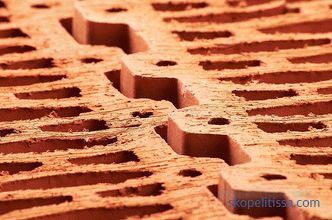
It might be interesting! B The article on the following link read about building houses from turnkey blocks.
Advantages and disadvantages of ceramic blocks
The production technology determines the following advantages of ceramic blocks:
-
Low thermal conductivity . The structure of the block (a large number of voids filled with air) determines one of its main positive qualities - excellent thermal insulation, allowing it to retain heat. Vertical joints have high tightness, not allowing cold bridges to appear.
-
Vapor permeability . Walls made of porous ceramic blocks are capable of controlling humidity; This allows you to maintain an optimal microclimate in the house.
-
Strength . After firing, ceramics does not contain moisture, therefore ceramoblocks have mechanical strength greater than silicate products (foam and gas blocks). This allows you not to use the support frame for buildings of high-rise.
-
Quality . Unlike silicate wall materials, factory conditions and special equipment are indispensable for the production of thermal blocks. The risk of using artisanal or defective products is extremely low.
-
Chemical and biological inertness . The material is immune to chemicals, mold and microorganisms.
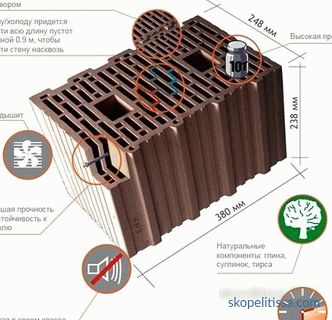
-
Environmental friendliness and fire safety . The blocks are made from safe for human health and non-flammable clay.
-
Soundproofing . A property that enhances the comfort of life in a porous ceramic house.
Professional builders identify the following features of ceramic blocks that are favorable for construction:
-
Durability . Duration of operation is 50 years or more (red building bricks - 25-50 years).
-
Light weight of the block . Due to this property, the load on the foundation is reduced. On filling of the basis it is possible to save.
-
Speed of laying . Due to the low weight, the presence of the groove-ridge system and the large size, the installation time is reduced by three times (when compared with the brick).
-
Size benefits . Large dimensions make it possible to refuse multilayered laying (one block of 510 mm thickness is often enough).
-
Saving masonry mortar . The amount of solution is reduced by 30% due to a smaller number of blocks.
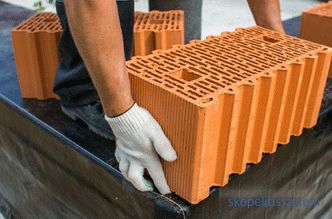
The image of an ideal building material tarnishes somewhat due to the presence of the following disadvantages :
-
Price . A porous ceramic block is a relatively expensive building material, especially if one considers the acquisition of additional blocks and a special solution.
-
Delivery difficulties . Impact loads - the scourge of porous products. Durable in masonry, porcelain blocks during transportation need careful handling.
-
High water absorption . The porosity of the wall structure requires additional moisture insulation, the same applies to storage conditions.
-
Processing complexity . In order to adjust the size, you need special tools.
-
Operational difficulties . If you want to attach the TV bracket to the wall, you will have to use a chemical anchor or a fixture specially designed for hollow ceramics.
On the features of warm ceramics in the following video:
It might be interesting! In article on the following link read about lightweight aggregate blocks.
Features of laying warm ceramics on walls: how to avoid mistakes
Everyone wants their own home to be reliable, comfortable and durable. Therefore, choosing one or another building material, most owners focus on operating parameters. But to achieve such an important goal as high-quality housing, one must take into account not only the performance of the material, but also the manufacturability of its use.The characteristics of the future house largely depend on the laying technology. The walls of the heat blocks correspond to the parameters declared by the manufacturer only when following the masonry instructions. The main construction errors include the following construction techniques:
-
Attracting experienced builders . Manufacturers produce instructions for their products, explaining the technology of installation. It presents the main options for technical solutions (combined with the base and floors, the erection of wall construction, masonry corners). To work with heat blocks, you should invite qualified masons with relevant experience, familiar with this technology and instructions.
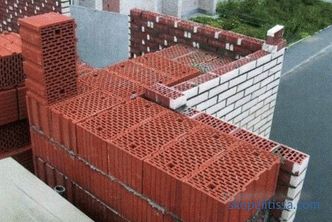
-
Using traditional cement mortar . Laying of blocks is carried out not only with the help of a proprietary warm mixture recommended by the manufacturer; does not exclude the use of cement mortar. Such replacement by some is considered unequal, since cement joints have a higher thermal conductivity and can significantly reduce the thermal efficiency of the building.
-
Filling vertical joints . According to the technology, joints up to 5 mm wide are not filled with a solution. But, if the width exceeds the standard value, or there is a block defect (no comb), filling is mandatory.
-
Tool change . For cutting ceramic blocks need specialized cutting tools. Using an improvised tool will result in an uneven edge, which can be compensated only by increasing the thickness of the masonry mortar and the thermal conductivity of this section of the wall.
About the cutting of a keramoblock with an alligator saw in the following video:
-
Combining materials . There are cases when for some reason builders use a combination of heat blocks and bricks in the construction of external walls. Brick masonry fragments have a thermal conductivity that is 4-5 times higher than that of porous ceramics. A house with combined walls will require a lot of heating costs; savings will have to forget.
-
Unjustified budget increase . For masonry of internal walls it is common to use blocks up to 250 mm thick. Instead, they often choose a more dimensional material (380 mm), which does not improve the quality of housing, but leads to higher costs.
-
Disregard for storage rules . If construction work is suspended, unfinished wall structures and unused blocks must be protected from atmospheric moisture.
Technology of prefabricated walls
Along with the manual method of erecting walls of porous ceramics, there is an alternative, automated option. The technology includes the manufacture of wall panels of ceramic blocks in the factory, their transportation and assembly at the construction site.
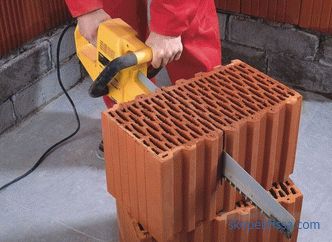
Thanks to the assembly of wall structures in the workshop of a wall made of ceramic blocks, such advantages of panel housing construction as high quality due to fast and accurate installation. The following facts are related to the features and benefits of the finished wall technology:
-
Suitability for low-rise construction .
-
Automation, reducing the cost price . Kneading of the solution and its application is carried out automatically. The solution has a strictly defined composition and is applied evenly (it has a verified thickness).
-
Reduction in the share of manual labor . When masonry hand cranes are used, which facilitates the display of heatblocks.
-
Quality Control . Work in workshop conditions facilitates the quality control of finished walls, regardless of the season.
-
Efficiency . Various semi-automatic installations allow from 90 to 150 m of high-quality masonry for an eight-hour work shift.
About the technology of finished walls in the following video:
It can be interesting! In article on the following link read about the building blocks.
Myths about warm ceramics
Despite its recent appearance, the porous block managed to acquire several myths related to the lack of consumer awareness. The most common are the following statements:
-
Walls of ceramic blocks have low strength . The strength of a single block and wall construction are different things that cannot be directly compared. In general, the strength of the wall is important, not a single element, and it depends not only on the quality of the blocks, but also on the skill of the bricklayer.Blocks in the masonry have multidirectional loads, and the quality of the mortar and the execution of the masonry can both reduce and increase the final strength. Conclusion: the strength of the block and the solution should be the same. Manufacturers, taking into account this fact, carry out tests for strength not of individual products, but of the whole masonry.
-
Walls of heatblocks do not need insulation . Some manufacturers argue that blocks with a thickness of less than 380 can not be further insulated. In fact, much depends on the climate of the region of construction. According to the reviews of professional builders (based on the conducted thermal engineering calculations), the walls do not need additional insulation, when the width of the blocks is at least 510 mm for the middle zone of Russia.
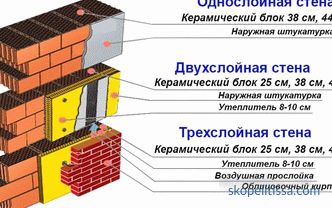
-
Ceramoblocks are destroyed when Strobleniya or cutting . Professionals produce a cut on a stationary machine (if the building has a complex architecture) or using a saw with a wear-resistant blade. When gouged on the surface of the wall pre-applied polymer plaster; shtrob turns smooth, with whole partitions.
-
Ceramoblocks are poorly suited for fastening structures . In fact, this problem has been solved almost simultaneously with the advent of porous blocks on the market — the development of dowels for slotted ceramics (made of synthetic material). If you need to fix something heavier on the wall, chemical anchors come to the rescue. The chemical composition is associated with the material of the block, forming a monolithic compound and holding the rod. The system can withstand a load of several hundred kilograms, which is rarely realized at home.
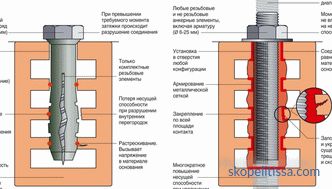
On our site you can familiarize yourself with the most popular designs of ceramic block houses. from construction companies represented at the exhibition Low-rise Country houses.
Conclusion
Many construction organizations are expanding the construction of country houses made of ceramic blocks; using proper masonry techniques minimizes costs and speeds up construction. The heir to the usual brick in experienced hands shows itself to be a high-tech promising building material, justifying the term "warm ceramics".
Rate this article, we tried for you

